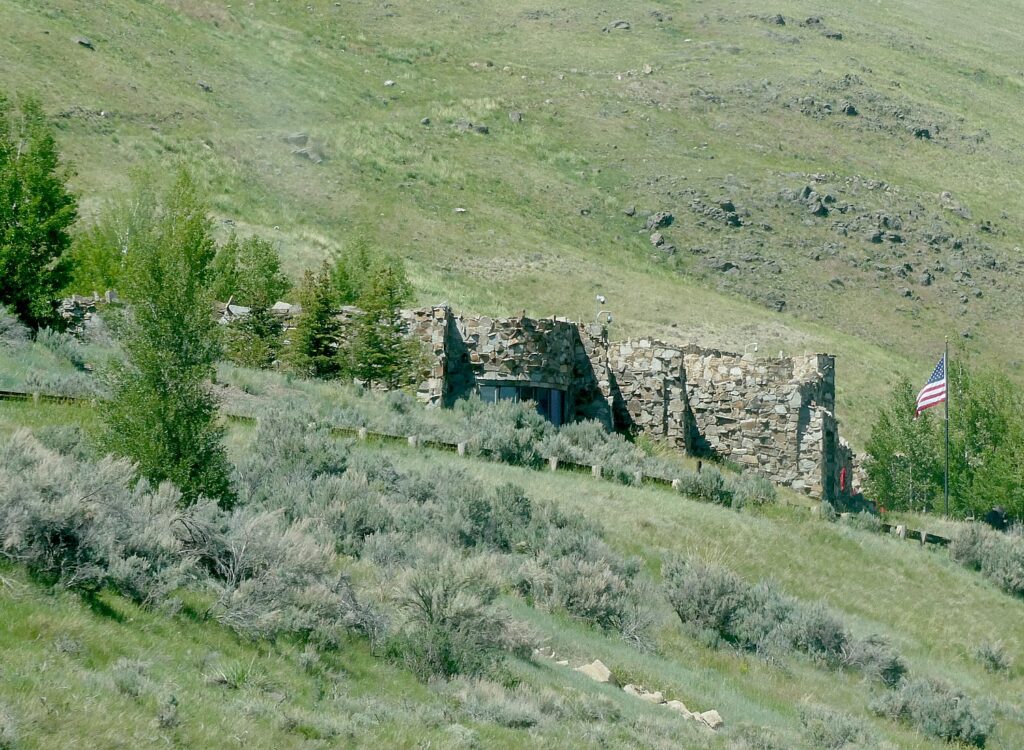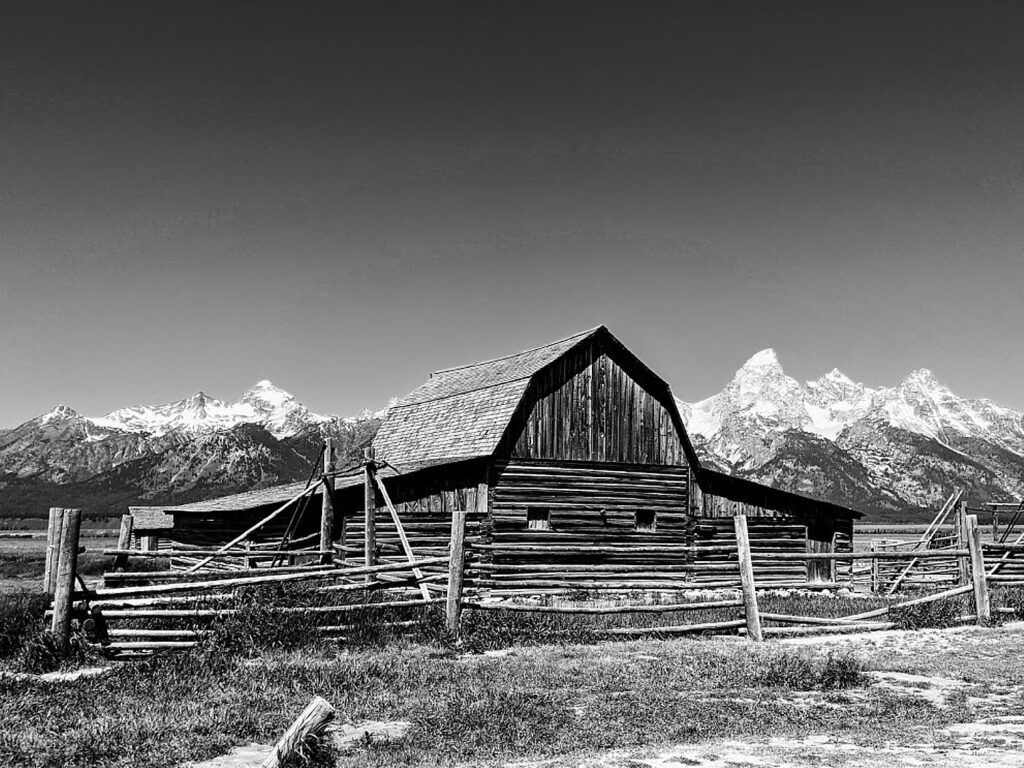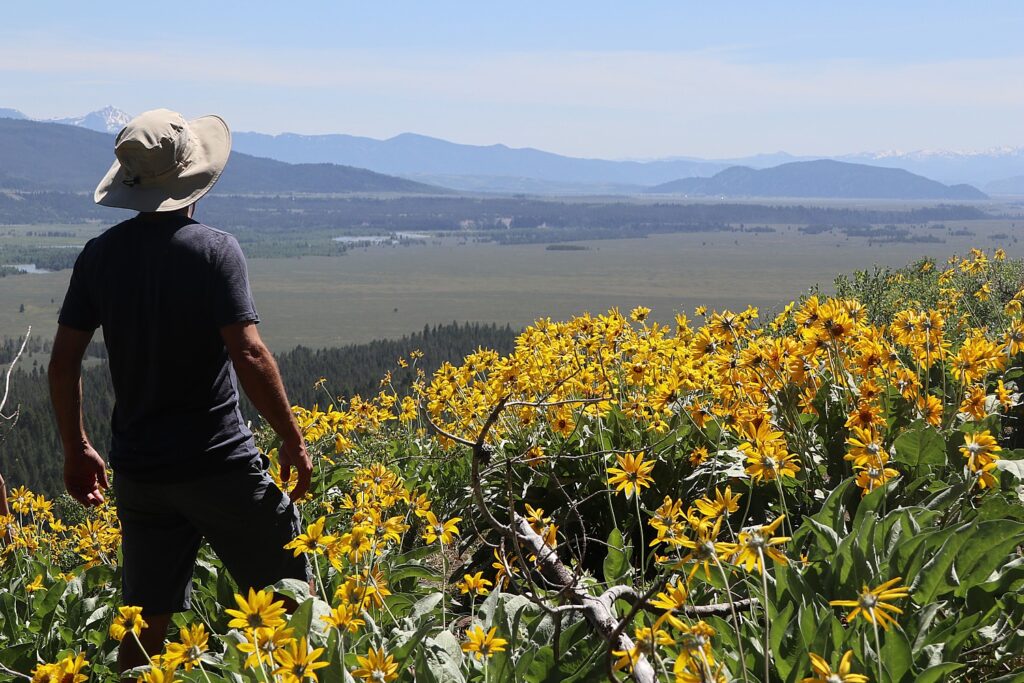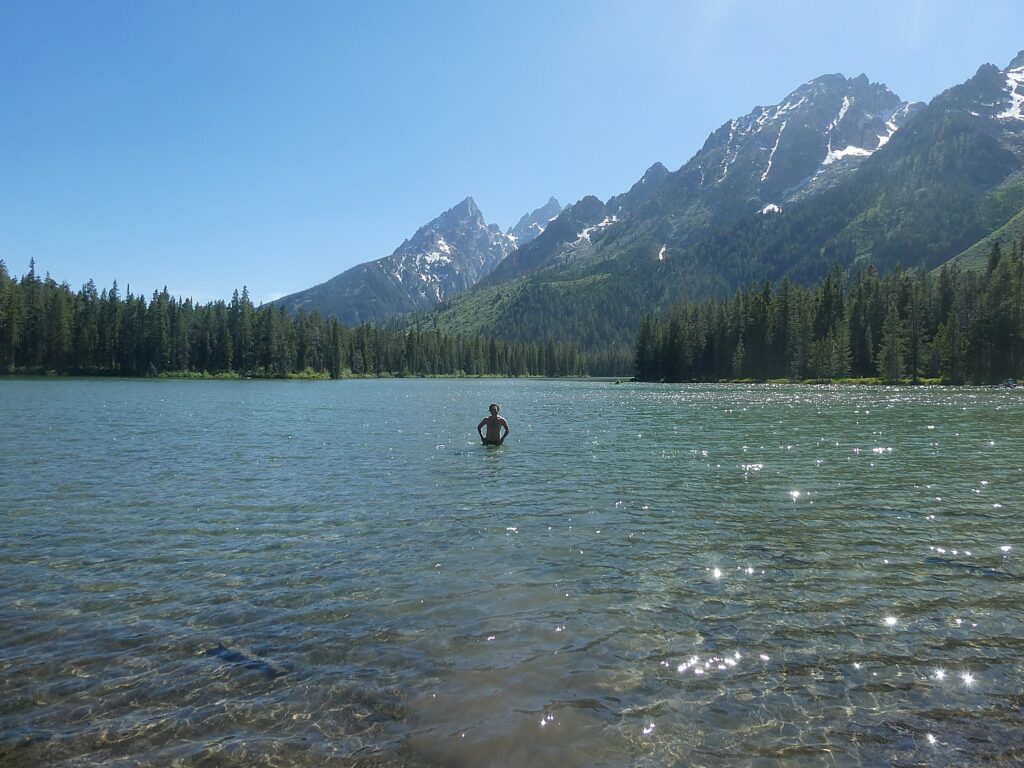
By Karen Rubin, Eric Leiberman, David Leiberman & Laini Miranda
Travel Features Syndicate, goingplacesfarandnear.com
If Yellowstone National Park makes you feel you have fallen into some surreal, other-worldly, “I can’t believe this is real” state, next-door neighbor Grand Teton National Park, barely an hour’s drive away, is Mother Nature in her purest, most pristine condition.
We leave West Jackson, going through Yellowstone Park. We realize we will miss Old Faithful by just a few minutes so go straight to West Thumb again (Eric had missed it the day before), wanting to be immersed, again, in its calming Zen – with the broad blue lake and intense thermal pools. The hour of the day changes the experience, but West Thumb is marvelous.
Then we are off to the Grand Tetons. Less than an hour’s drive away, Grand Teton National Park is a majorly different landscape and different experience from Yellowstone.
Leaving Yellowstone National Park from the South entrance, we drive into the Grand Teton National Park on the John D. Rockefeller Jr Memorial Parkway, encompassing 24,000 acres. Rockefeller bought up the land to preserve it and donated 32,000 acres to the federal government.

Here, there are sweeping vistas to snow-capped mountain peaks. Indeed, the 2.7 billion year old rocks in the core of the Teton Range are some of the oldest in North America, yet the mountains are mere youngsters in the planet’s geology. Ten million years ago, the movement on the Teton fault generated massive earthquakes, pushing up the mountains while the valley floor dropped, then erosion and glacial action sculpted the landscape and created habitats for plants and wildlife.
We see this on display when we stop at the overlook to Mount Moran, which, the notes say, “reflects all the geologic forces shaping the Teton Range. Formed of a massive block of metamorphic gneiss, cut by dikes of igneous granite and diabase, capped by sedimentary sandstone and flanked by glaciers, this formidable peak dominates the park’s northern skyline. The gneiss and granite are among the oldest rocks in North America, 2.7 and 2.5 billion years old. They form the core of the Teton Range. The vertical ‘Black Dike’ of 775 million year old diabase is about 150 feet wide and juts from the mountain face because the surrounding gneiss has eroded away.”
We pick up a picnic lunch at a well-stocked market at the Colter Bay Village and drive to the Chapel of the Sacred Heart for a scenic place for a picnic (swim, also), stopping along the way for some of the iconic views of the park, like Mount Moran.

We head next to Jenny Lake, one of the most visited places in Grand Teton National Park for good reason. Tucked away at the base of the Teton Range, the lake is a centerpiece of the park. From the east shore, you have stunning views of Teewinot Mountain, Mount St. John, and into Cascade Canyon. From the west shore, you can look back across the lake towards the valley of Jackson Hole. Here you find the Jenny Lake Visitor Center, housed in the historic Harrison Crandall Studio, dating from the 1920s.

We opt for the most scenic hike, which proves to offer just the right amount of challenge, that takes us to the most impressive features – Hidden Falls and Inspiration Point (about 3 miles one way), with an option to either walk back, finish the loop (5 miles more), or take the shuttle boat (fee charged) from just below Inspiration Point back to the Jenny Lake Lodge.

The hike is absolutely gorgeous and fun – Hidden Falls, cascading 100 feet, is stunning, and the extra hike a half-mile almost straight up to Inspiration Point gets interesting with a rocky, sheer cliff as a special finishing touch to make you feel you have really accomplished something.

From here, you can connect with the Cascade Canyon trail, and we go in search of a spectacular view that is supposed to be just about the next bend, and the next bend, and the next.

Cascade Canyon, a glacially carved u-shaped canyon, passes between Teewinot and Mount St. John to provide easy access into the Teton backcountry. This out-and-back trail is a popular option with visitors who want to get into the mountains without gaining a significant amount of elevation. While following Cascade Creek, the trail provides spectacular views of the surrounding peaks, including the Grand Teton, Mount Owen, and Teewinot. This trail also provides an opportunity to spot wildlife like moose and bears (really recommended to have bear spray with you and we heard a harrowing story from a restaurant manager encountering a bear here), as well as some of our alpine species like pika. (We spot a marmot.)

The trail continues 4.4 miles back into the canyon before splitting but you can turn back, making the hike as long or as short as you like. (Cascade Canyon is accessible via the Jenny Lake Loop Trail, 14.6 miles roundtrip, or you can shorten the hike to 8.8 miles by taking the shuttle boat.)

David, Laini and Eric continue further on the Cascade Canyon trail while I return to Inspiration Point for our hike back down, deciding to take the shuttle boat back. (If you are planning on using the shuttle boat, check their hours and prices – we are told to be at the dock no later than 7 pm; tickets are purchased directly at the boat dock; you can also rent a kayak at the marina.)

We finish our day in Jackson, an absolutely stunning town that makes a great effort (and success) to keep its Western charm.

We manage to get a table on the outdoor patio at Roadhouse Brewing Co for dinner (sensational beer).

Our second day in the Grand Tetons starts with a photo safari, as we hunt for iconic photos of the Grand Tetons. Indeed, the layout of the Grand Tetons – those vast vistas with the backdrop of snow-capped mountain peaks – makes this area especially popular with photographers. (Actually, Jackson Hole is a base for one of the most iconic wildlife photographers, Thomas D. Mangelsen, who has a gallery in Jackson, Images of Nature, as well as several other marvelous galleries; you can also visit the National Museum of Wildlife Art, 307-733-5771, www.wildlifeart.org.)

So we set out to find the iconic places, pretty much following Route 89/191 before swinging back on the Teton Park Road. (Of course, the time to be here is sunrise when the colors are most dramatic, but we do the best we can with what we have.)

We head to the top photo site on everyone’s list, Mormon Row on Antelope Flats, and the most photographed barns in Wyoming, possibly the world (probably because it is billed as the “most photographed barn”): the Thomas Alma Moulton Barn with the pointed roof and John Moulton Barn with the rounded roof, in front of the towering Tetons. If you are really lucky, a bison or few may wander into view. The structures date back 1890s, built by Church of Jesus Christ of Latter-day Saints homesteaders. The best time is at sunrise.

Next is Schwabacher’s Landing – absolutely so picturesque. Here I am lucky to have the river calm and reflecting the mountain range. We walk a short distance and find a lovely spot under a tree to have our picnic lunch. I spot a beaver dam which is largely responsible for setting the scene, by damming up this branch of the Snake River and creating the ponds that let us photograph the reflection of the Tetons when the water is calm.

We continue on to the Snake River Overlook, a scene made iconic by Ansel Adams who was commissioned to photograph it for the National Park Service in 1941. His famous photograph showed the Snake River meandering through a pine forest, with the Tetons in the background, but in the more than 75 years since, pine trees have blocked a lot of the river bend so you can’t re-create the scene. Nonetheless, you feel you are channeling, or at least paying homage to Ansel Adams, when you shoot your own, using the filter to change to black-and-white for better effect.

Right at the Elk Ranch Flats, we get that iconic Wyoming image of a herd of bison in front of the snow-capped mountains.

The famous Oxbow Bend provides another great reflection of the Grand Tetons and Mount Moran in Snake River.

We next head over to the Signal Mountain road, off of the Teton Park Road, for the sweeping views of the valley from the summit.From here, you can see clearly the geology that controls the park’s natural communities, from valley wetlands to mountain alpine. The NPS notes describe how Ice Age glaciers periodically blanketed this landscape, last retreating 14,000 years ago, leaving behind river channels, outwash plains, glacial moraines, potholes, deep canyons and jagged peaks. Glaciers act like conveyor belts depositing rocky debris as ridges called moraines that contain rocks ground to the consistency of flour. Rock flour retains moisture allowing lodge pole pine forests to flourish. As glaciers retreat, blocks of ice drop to the valley floor and become buried in outwash gravel and when the ice melts, the resulting depression (pothole) forms a pocket of forest or wetland surrounded by a sea of sagebrush in the outwash plain. (This place is best at sunset, but then you would have to drive back down the steep, winding, narrow road in the dark).
Of course, the best photos are taken at sunrise and sunset – but that isn’t always practical, so you do the best with what you have.

After our photo/sights safari, we want to literally get into the swim of this exquisite wilderness. We head back to the Jenny Lake Lodge area to hike along String Lake trail, just north of Jenny Lake, which connects to Leigh Lake. Again, the scenery is just breathtaking -stunning views of the “Cathedral Group,” which includes 12,325-foot Teewinot Mountain, 13,770-foot Grand Teton and 12,928-foot Mt. Owen. At almost six-tenths of a mile we pass the Leigh Lake Trailhead. From here the trail continues to follow along the eastern shore of the narrow lake. We go purposefully to take in the gorgeous view of Mt. Moran, which, at 12,605 feet is the fourth highest mountain in Grand Teton National Park. It was named for artist Thomas Moran whose landscape paintings played a critical role in the creation of Yellowstone National Park, the world’s first national park (as we saw when we hiked the Grand Canyon of the Yellowstone trail).

On the way back, we scout a great place for swimming in the glacial water (many of the areas have communal bear boxes for you to stow your stuff while you swim; we actually spotted some very large scat on the small wooden bridge). Refreshing. Brisk. Exhilarating. And the backdrop!
More help to plan your visit to Grand Teton National Park: www.nps.gov/grte/planyourvisit/index.htm.
The town of Jackson is really fun, and so striking. The mountains come right into town (Snow King ski resort is right there); the National Elk Refuge is there (the herd seems to spend the summer elsewhere); an incredible network of bike paths take you all the way into the national park (there are many bike rental shops, plus City Bike which Eric and David used to explore).

We finish the evening in Jackson at Figs, a Lebanese restaurant (who would imagine!) at the swank Jackson Hotel (the meal is excellent), then wander around.

You can have a western musical dinner (“Seven Brides for Seven Brothers” and a saloon-style dinner at the Playhouse (Monday-Saturday, 307-733-6994, www.MTIShows.com.

Check out the Million Dollar Cowboy Bar, a popular place for drinks, dancing and live entertainment since 1937, with an iconic vintage neon sign of a cowboy on a bronco.
The Elk Antler Arches that mark the four corners of Jackson’s historic George Washington Memorial Park (Town Square), is another iconic feature of Jackson. A stage coach makes a regular rotation around the square.

The next morning, we get to explore the town more, before I head out to the Jackson Hole Airport and David and Laini continue their road trip in their Subaru Forester they converted into a camper van, for points west.

We loved our stay at the Elk Country Inn, delighted with the accommodations (we booked months ago) that include two queen beds plus a sleeping loft with another queen bed, refrigerator, microwave, coffee maker, balcony, parking. The hotel also has an indoor/outdoor pool, laundry facilities (really appreciated), serves a lovely full breakfast, and is walking distance to everything, and a very short drive into the Grand Teton National Park. (Elk Country Inn, 480 West Pearl Avenue, Jackson 83001 WY, 307-733-2364).
(The Elk Country Inn is one of the Town Square Inns of Jackson Hole; the others are the 49er Inn & Suites, Antler Inn and Cowboy Village Resort, 800-4-TETONS, townsquareinns.com).
We split our stay among three hotels, staying two nights in each – in Gardiner, West Jackson and Jackson – researching and booking on hotels.com and booking.com. We appreciated the ability to cancel reservations (sometimes a special rate is nonrefundable, but most bookings on hotels.com can be cancelled for free) which gives us the ability to modify our itinerary. Seeing all the “no vacancy” signs everywhere we went confirmed we were clever to book early, especially this year when travel is resurging and the national parks top the list.
Whitewater Rafting Adventure in Big Sky
Between Yellowstone National Park and Grand Teton, we spend a day in Big Sky, Montana, to go whitewater rafting on the Gallatin River, with Geyser Whitewater Expeditions.

(Crystal Images Photography photo by Rob Hunt/Bigskyphotos.com )
We take the half-day (three hours) rafting trip on the Lower River, which affords “the most exciting” part with class III-IV rapids. Indeed it is. There is very little floating, most of the time being splashed, bumped, soaked and generally thrilled as you go through rapids with names like Screaming Left, Straightaway, House Rock and down the Mad Mile. Much of the setting is scenic, under the rock walls, but much is also alongside the road. The rafting is really fun, and our guide, Clay Kincer, is excellent – competent (most important), funny and informative and clearly enjoying his job. They rent the wetsuit as a separate charge (usually recommended).

There is also an Upper Whitewater trip, with Class II-III rapids (not as rough but you get some good soakings), and a scenic float (class I-II gentle cruise).
The company, founded in Big Sky by Eric Becker in 1992, also offers Adventure Zipline Tour; Nature Zip Tour (a half-day rafting and a pass to the Zipline Adventure Park), whitewater kayaking, and an Ousel Falls bicycle adventure (46651 Gallatin Road, Gallatin Gateway, MT, 406-995-4989, www.raftmontana.com)
______________________
© 2021 Travel Features Syndicate, a division of Workstyles, Inc. All rights reserved. Visit goingplacesfarandnear.com, www.huffingtonpost.com/author/karen-rubin, and travelwritersmagazine.com/TravelFeaturesSyndicate/. Blogging at goingplacesnearandfar.wordpress.com and moralcompasstravel.info. Send comments or questions to FamTravLtr@aol.com. Tweet @TravelFeatures. ‘Like’ us at facebook.com/NewsPhotoFeatures

